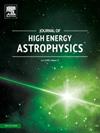基于神经网络的伽马射线暴模型独立校准
IF 10.5
4区 物理与天体物理
Q1 ASTRONOMY & ASTROPHYSICS
引用次数: 0
摘要
Λ冷暗物质(ΛCDM)宇宙学模型在预测宇宙结构和演化方面非常成功,但最近的精确测量突出了差异,特别是从局部和早期宇宙数据推断的哈勃常数。伽玛射线暴(GRBs)为宇宙学测量提供了一个很有前途的选择,能够达到比传统距离指示器更高的红移。这项工作利用grb来完善独立于ΛCDM框架的宇宙学参数。利用长GRB的白金汇编,我们通过人工神经网络(ann)校准了Dainotti关系(GRB亮度特性之间的经验相关性)作为标准蜡烛。我们分析了二维和三维的Dainotti校准关系,利用人工神经网络驱动的马尔可夫链蒙特卡罗方法最小化校准参数中的散射,从而获得稳定的哈勃图。这种基于人工神经网络的校准方法具有优于高斯过程的优点,避免了核函数依赖和过拟合等问题。我们的研究结果强调需要独立于模型的校准方法来解决GRB亮度变异性的系统性挑战,最终以稳健的方式扩展宇宙距离阶梯。通过解决红移演化和减少系统的不确定性,grb可以作为可靠的高红移距离指示器,为当前的宇宙张力提供关键的见解。本文章由计算机程序翻译,如有差异,请以英文原文为准。
Model-independent calibration of Gamma-Ray Bursts with neural networks
The Λ Cold Dark Matter (ΛCDM) cosmological model has been highly successful in predicting cosmic structure and evolution, yet recent precision measurements have highlighted discrepancies, especially in the Hubble constant inferred from local and early-Universe data. Gamma-ray bursts (GRBs) present a promising alternative for cosmological measurements, capable of reaching higher redshifts than traditional distance indicators. This work leverages GRBs to refine cosmological parameters independently of the ΛCDM framework. Using the Platinum compilation of long GRBs, we calibrate the Dainotti relations—empirical correlations among GRB luminosity properties—as standard candles through artificial neural networks (ANNs). We analyze both the 2D and 3D Dainotti calibration relations, leveraging an ANN-driven Markov Chain Monte Carlo approach to minimize scatter in the calibration parameters, thereby achieving a stable Hubble diagram. This ANN-based calibration approach offers advantages over Gaussian processes, avoiding issues such as kernel function dependence and overfitting. Our results emphasize the need for model-independent calibration approaches to address systematic challenges in GRB luminosity variability, ultimately extending the cosmic distance ladder in a robust way. By addressing redshift evolution and reducing systematic uncertainties, GRBs can serve as reliable high-redshift distance indicators, offering critical insights into current cosmological tensions.
求助全文
通过发布文献求助,成功后即可免费获取论文全文。
去求助
来源期刊

Journal of High Energy Astrophysics
Earth and Planetary Sciences-Space and Planetary Science
CiteScore
9.70
自引率
5.30%
发文量
38
审稿时长
65 days
期刊介绍:
The journal welcomes manuscripts on theoretical models, simulations, and observations of highly energetic astrophysical objects both in our Galaxy and beyond. Among those, black holes at all scales, neutron stars, pulsars and their nebula, binaries, novae and supernovae, their remnants, active galaxies, and clusters are just a few examples. The journal will consider research across the whole electromagnetic spectrum, as well as research using various messengers, such as gravitational waves or neutrinos. Effects of high-energy phenomena on cosmology and star-formation, results from dedicated surveys expanding the knowledge of extreme environments, and astrophysical implications of dark matter are also welcomed topics.
 求助内容:
求助内容: 应助结果提醒方式:
应助结果提醒方式:


